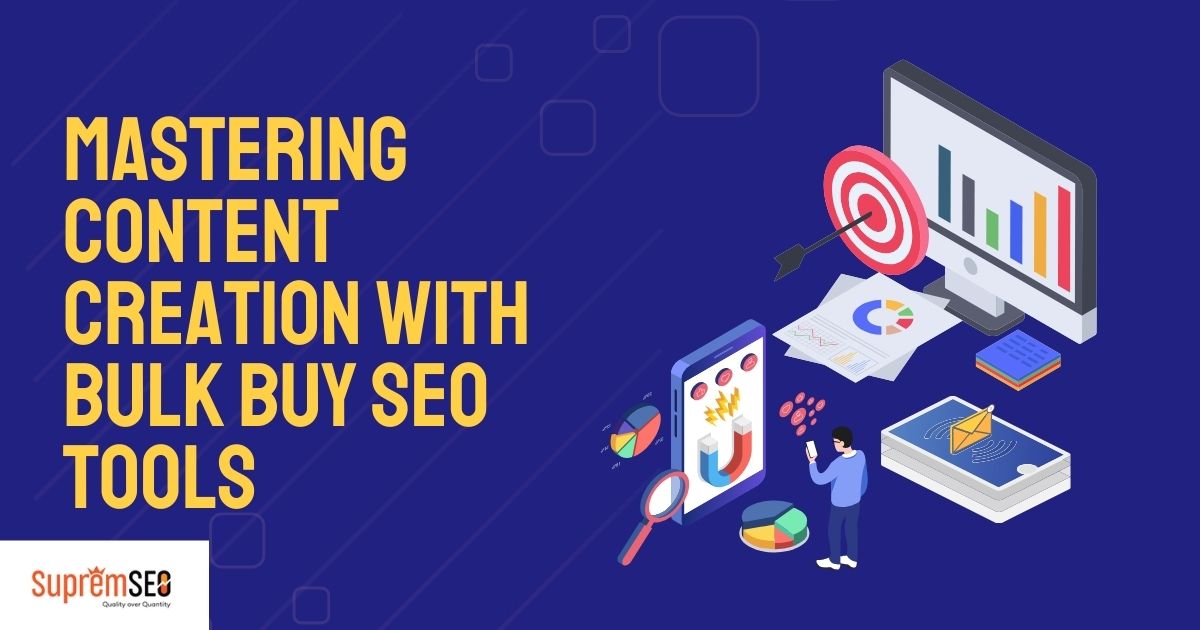Content creation is an essential component of any successful SEO strategy. Creating high-quality and engaging content is crucial for improving website rankings and driving traffic to a business’s website. However, producing a large volume of quality content can be time-consuming and challenging. This is where Bulk Buy SEO tools come in, which can help businesses create content efficiently and effectively.

Bulk buy SEO AI content tools are designed to help businesses generate large amounts of content quickly and easily. These tools can help with everything from generating content ideas to writing and editing articles. By using bulk-buy SEO tools, businesses can save time and resources while still producing content in bulk that is optimized for search engines. Businesses that master content creation with bulk buy SEO tools can gain a competitive edge in their industry. By creating a large volume of quality content, businesses can enhance their online presence, improve their website’s search engine rankings, drive more traffic to their website, and ultimately increase their revenue. With the right tools and strategies, any business can master content creation and achieve success in SEO.
Understanding SEO Tools and Platforms

The Role of SEO Tools in Content Creation
SEO tools play a crucial role in content creation by providing insights into keyword research, competitor analysis, and on-page optimization.
These tools help content creators identify the most relevant keywords to target, analyze their competitors’ content strategies, and optimize their own content for search engines.
Comparing Popular SEO Tools: Semrush, Ahrefs, Surfer, and More
Several popular SEO tools are available on the market, including Semrush, Ahrefs, Surfer, and more. Each tool has unique features and capabilities, making it suitable for different types of content creators.
Semrush is an all-in-one SEO platform that offers a wide range of features, including keyword research, competitor analysis, and on-page optimization.
Ahrefs, on the other hand, is a backlink analysis tool that provides insights into a website’s backlink profile. Surfer is a content optimization tool that analyzes the content of top-ranking pages and provides recommendations for optimization.
Integrating SEO Tools with CMS for Streamlined Content Planning
Integrating SEO tools with content management systems (CMS) can help content creators streamline their content planning process. By integrating SEO tools with CMS, content creators can get insights into keyword research, competitor analysis, and on-page optimization directly within their CMS. Several CMS platforms, such as WordPress, offer plugins that allow users to integrate SEO tools with their CMS. These plugins enable users to optimize their content for search engines without leaving their CMS.
Crafting a Content Strategy for SEO

Crafting a content strategy for SEO is a crucial step in achieving success in online marketing. A well-planned content strategy can help businesses reach their target audience, increase website traffic, and improve their search engine rankings.
In this section, we will discuss the key components of crafting a content strategy for SEO.
Keyword Research and Analysis
Keyword research is the foundation of any successful SEO content strategy. It involves identifying the keywords and phrases that your target audience is using to search for information related to your business. By conducting keyword research, businesses can create content that is optimized for search engines and relevant to their target audience. Businesses can use various tools, such as Google Keyword Planner, Ahrefs, and SEMrush, to conduct keyword research. These tools can help businesses identify high-volume keywords, analyze their competition, and generate new content ideas.
Competitor and Market Analysis
Analyzing your competitors and the market is another critical component of crafting a content strategy for SEO. By analyzing their competitors’ content, businesses can identify content gaps and create more informative and valuable content for their target audience.
Additionally, analyzing the market can help businesses identify new trends, topics, and keywords to incorporate into their content strategy.
Creating a Content Calendar and Scheduling
Creating and scheduling content is the final step in crafting a content strategy for SEO. A content calendar helps businesses plan and organize their content strategy, ensuring that they consistently publish high-quality content.
Additionally, scheduling content allows businesses to publish their content at the optimal time for their target audience, increasing the chances of engagement and shares. To create a content calendar, businesses can use various tools such as Google Sheets, Trello, and Asana. These tools can help businesses organize their content ideas, plan their publishing schedule, and collaborate with their team.
Optimizing Content for Search Engines and Users
Creating high-quality content is only half the battle. To ensure that your content reaches its target audience, it’s essential to optimize it for search engines and users. By doing so, you can increase engagement, authority, and, ultimately, conversions.
Writing High-Quality, Relevant Content
Writing high-quality, relevant content is the cornerstone of content optimization. Search engines prioritize content that is informative, engaging, and relevant to the user’s search query. To achieve this, it’s crucial to conduct thorough keyword research and integrate the keywords naturally into the content. However, it’s equally important to ensure that the content is written for the user, not the search engine. The content should be informative, engaging, and easy to read. It should also have a clear structure and logical flow and be free from spelling and grammatical errors.
Enhancing User Experience with Visuals and Readability
User experience is a critical factor in content optimization. Users are more likely to engage with content that is visually appealing, easy to read, and well-structured. To achieve this, it’s essential to incorporate visuals such as images, videos, and infographics into the content.
Additionally, the content should be easy to read, with short paragraphs, subheadings, and bullet points. Bold and italicized text can also help emphasize key points and improve readability.
Advanced SEO Techniques: Internal Links and Meta Descriptions
In addition to writing high-quality, relevant content and enhancing user experience, there are several advanced SEO techniques that can further optimize your content. One such technique is internal linking, which involves linking to other pages on your website. Internal linking can help to increase the authority of your website and improve the user experience by providing additional relevant information. Another advanced SEO technique is the use of meta descriptions. Meta descriptions are short descriptions that appear on search engine results pages (SERPs) and provide a summary of the content. By optimizing the meta descriptions, you can increase the click-through rate and drive more traffic to your website.
Measuring and Improving Content Performance
Creating high-quality and engaging content is essential for SEO success. However, it is not enough to just create content and hope for the best. It is important to measure and track the performance of your content to identify areas for improvement. This section will discuss how to utilize analytics to track SEO performance and adapt content based on performance metrics.
Utilizing Analytics to Track SEO Performance
One of the most important tools for measuring content performance is analytics. Analytics can provide valuable insights into how your content is performing, including traffic, engagement, and conversions. By tracking these metrics, you can identify which content is resonating with your audience and which content needs improvement. Google Analytics is one of the most popular analytics tools for tracking SEO performance. It provides a wealth of data, including traffic sources, bounce rates, and conversion rates. By analyzing this data, you can identify which pages are driving the most traffic and which pages are underperforming.
Adapting Content Based on Performance Metrics
Once you have identified areas for improvement, it is important to adapt your content based on performance metrics. This can involve making changes to the content itself, as well as optimizing the content for search engines. Making changes to the content itself can involve updating the title, adjusting the tone or style, or adding more visuals. It can also involve revising the content to better align with the needs and interests of your target audience. Optimizing the content for search engines can involve making changes to the metadata, such as the title tag and meta description. It can also involve optimizing the content for specific keywords and phrases to improve rankings and drive more organic traffic.
Frequently Asked Questions
How can bulk-buy SEO tools enhance content creation efficiency?
Bulk buy SEO tools can enhance content creation efficiency in several ways. First, they can automate certain tasks, such as keyword research, enabling content creators to focus on crafting high-quality content. Second, they can provide insights and analytics on content performance, allowing teams to optimize their strategies. Finally, they can streamline the content creation process by integrating with content management systems and other tools.
What are the key features to look for in SEO tools for content creators?
When choosing SEO tools for content creators, there are several key features to look for. Firstly, the tool should have a user-friendly interface and be easy to navigate. Secondly, it should provide comprehensive keyword research and analysis capabilities, including competitor analysis and search volume data. Thirdly, it should offer on-page optimization recommendations and content analysis tools. Finally, it should integrate with other tools and platforms used in the content creation process.
What is the cost-benefit analysis of investing in premium SEO tools for content teams?
Investing in premium SEO tools for content teams can be a cost-effective solution in the long run. While the initial investment may be higher, these tools can save time and resources by automating certain tasks and providing valuable insights. Additionally, they can improve the quality and performance of content, leading to higher search rankings and increased traffic. Ultimately, the cost-benefit analysis will depend on the specific needs and goals of the content team.
How do SEO tools integrate with content management systems?
SEO tools can integrate with content management systems in several ways. Some tools offer plugins or extensions that can be installed directly into the CMS, allowing for seamless integration. Others offer APIs or webhooks that can be used to connect the two systems. By integrating SEO tools with content management systems, content creators can streamline their workflows and optimize their content for search.
What are the best practices for using SEO tools during the content creation process?
When using SEO tools during the content creation process, there are several best practices to keep in mind. First, it’s important to conduct thorough keyword research to identify relevant and high-volume search terms. Second, content should be optimized for on-page factors such as meta descriptions, headers, and internal linking. Third, content should be high-quality and engaging, with a focus on providing value to the reader. Finally, content creators should use analytics and insights from SEO tools to continually improve their strategies.
How do content creators measure the success of SEO strategies with these tools?
With these tools, content creators can measure the success of SEO strategies by tracking metrics such as search rankings, traffic, and engagement. Additionally, they can use analytics tools to gain insights into user behavior and identify areas for improvement. By continually monitoring and analyzing performance data, content creators can optimize their strategies and improve the effectiveness of their content.










